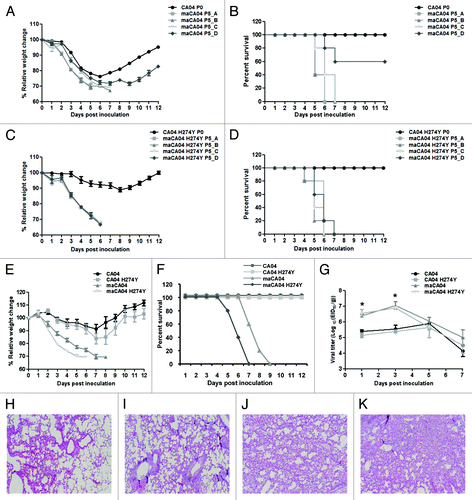Figures & data
Figure 1. Comparison and characterization of virulence between mouse-adapted and parental viruses in BALB/c mice. Five independent serial lung-to-lung passages for each virus (CA04 and CA04H274Y) were performed. After adaptation, 104.0 TCID50 of the passaged viruses and their parental strains were administered intranasally (i.n.). Body weight loss and survival rate of the parental CA04 and CA04H274Y with their corresponding mouse-adapted variants (maCA04_A, maCA04_B, maCA04_C, maCA04_D, and maCA04H274Y_A, maCA04H274Y_B, maCA04H274Y_C, and maCA04H274Y_D, respectively) were monitored in groups of 5 mice for 12 d p.i. (A–D). The number of passages is represented by ‘P’ followed by the name of the individually passaged viruses on the figure. For further characterization of lethal mouse-adapted oseltamivir-resistant variants, mouse-adapted viruses were plaque-purified and selected. Next, 103.0 TCID50 of plaque-purified mouse-adapted CA04, mouse-adapted CA04H274Y, and their parental viruses were administered to mice i.n. Body weight loss (E) and survival rate (F) were monitored daily for 12 d p.i. Groups of 12 mice were also given 103.0 TCID50, and lung samples were collected 1, 3, 5, and 7 d p.i. to determine lung viral titers (3 heads/day) (G). Standard hematoxylin and eosin staining of lung tissues infected by CA04 (H), CA04H274Y (I), mouse-adapted CA04 (J), and mouse-adapted CA04H274Y (K) was examined 5 d p.i. (magnification × 100). *P < 0.05 (unpaired t test, two-tailed) of viral lung titers between wild-type CA04 and CA04H274Y viruses and mouse-adapted CA04 and CA04H274Y viruses. Error bar shown in (C, E, and G) represents standard error mean (SEM).
